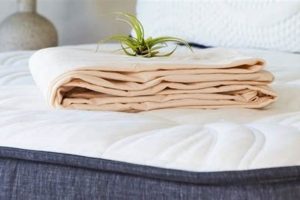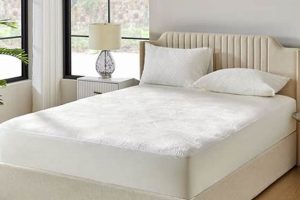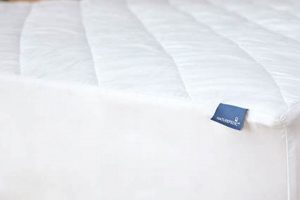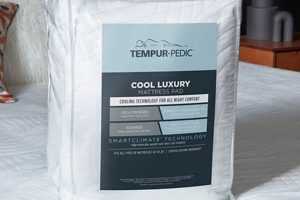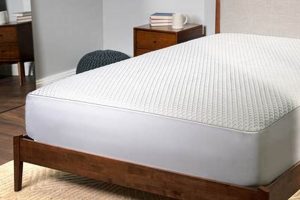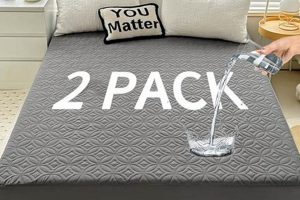A barrier designed to shield a bed’s sleeping surface from allergens constitutes a key component of a healthy sleep environment. These encasements typically feature tightly woven fabrics or specialized membranes intended to prevent the accumulation of dust mites, pet dander, mold spores, and other common irritants within the mattress fibers. For example, individuals sensitive to dust mite allergens may utilize this type of bedding accessory to mitigate nighttime allergic reactions.
The utilization of these protective covers provides several significant advantages. It reduces exposure to allergens, leading to improved respiratory health and decreased allergy symptoms. Furthermore, it extends the lifespan of the underlying mattress by safeguarding against spills, stains, and general wear and tear. Historically, the need for allergen control stemmed from increased awareness of indoor air quality and the prevalence of allergies affecting sleep quality and overall well-being.
The following sections will delve into the specific materials used in construction, the features to consider when selecting a suitable option, proper care and maintenance procedures, and the potential impact on sleep quality and overall health.
Selecting and Utilizing a Protective Allergen Barrier
Optimizing the lifespan and hygienic properties of a mattress necessitates careful selection and implementation of a protective barrier. The following guidelines provide key considerations for achieving these objectives.
Tip 1: Fabric Density is Paramount: Select a protector with a tightly woven fabric structure. This impedes the penetration of dust mites and other microscopic allergens. A thread count exceeding 280 is generally recommended.
Tip 2: Consider Waterproofing Needs: Evaluate the need for waterproofing based on potential exposure to spills or incontinence. If required, ensure the waterproof layer is breathable to prevent moisture buildup and discomfort.
Tip 3: Allergen Certification is Essential: Look for certifications from recognized organizations like the Asthma and Allergy Foundation of America (AAFA). This validates the protector’s effectiveness in reducing allergen exposure.
Tip 4: Prioritize Breathability: Opt for materials that promote airflow. Breathable fabrics minimize heat retention and prevent the development of a damp environment conducive to mold growth.
Tip 5: Secure Encasement is Crucial: Choose a protector that fully encases the mattress with a secure zipper closure. This prevents allergens from entering the mattress from any side.
Tip 6: Regular Cleaning is Mandatory: Adhere to the manufacturer’s cleaning instructions. Frequent washing, typically every 6-8 weeks, removes accumulated allergens and maintains hygiene.
Tip 7: Replacement Considerations: Even with proper care, consider replacing the protector every 1-2 years. Over time, the fabric may lose its effectiveness due to wear and tear.
Selecting and utilizing an allergen barrier correctly translates to a healthier sleep environment. Its regular maintenance is essential for the continual mitigation of allergen exposure and preservation of the mattress.
The subsequent sections will discuss material compositions, advanced features and their selection, and the impact of these protective measures on overall well-being.
1. Material Density
Material density, particularly concerning thread count and weave tightness, is a critical determinant of a barrier’s efficacy in mitigating allergen exposure. The fabric’s structure directly influences its capacity to prevent the passage of microscopic allergens, such as dust mites and their associated waste products. Higher density generally correlates with enhanced allergen impermeability.
- Thread Count and Allergen Penetration
Thread count, defined as the number of horizontal and vertical threads per square inch of fabric, serves as a primary indicator of density. A higher thread count results in smaller interstitial spaces within the weave, impeding allergen penetration. For instance, a fabric with a thread count exceeding 280 is commonly recommended for allergen protection due to its reduced pore size.
- Weave Tightness and Barrier Effectiveness
Beyond thread count, the specific weave pattern influences barrier performance. Tightly woven fabrics, such as those employing a plain or twill weave with minimal gaps, offer superior allergen resistance compared to looser weaves. The closeness of the weave restricts the movement of allergens through the fabric, effectively trapping them on the surface for subsequent removal through washing.
- Material Composition and Density Correlation
The type of fiber utilized in the construction also affects overall density and effectiveness. Tightly woven microfiber fabrics, often composed of polyester or nylon, exhibit inherently high densities due to the fine diameter of the individual fibers. This inherent density, combined with a tight weave, provides a formidable barrier against allergen intrusion, surpassing that of some natural fibers with lower thread counts.
- Durability and Long-Term Allergen Control
Material density contributes significantly to the protector’s longevity and sustained allergen control. Denser fabrics are generally more resistant to abrasion and wear, maintaining their structural integrity over extended use and repeated washings. This durability ensures that the barrier remains effective in preventing allergen passage throughout the product’s lifespan.
In summary, material density, encompassing thread count, weave tightness, and fiber composition, plays a pivotal role in determining the effectiveness of mattress encasements. The selection of a protector with a high-density fabric construction is crucial for minimizing allergen exposure and establishing a healthier sleep environment. Regular assessment of fabric integrity is important to ensure continued effectiveness.
2. Water Resistance
Water resistance, within the context of mattress protection, constitutes a crucial factor in maintaining a hygienic and allergen-controlled sleep environment. The primary function of water resistance in this application is to prevent liquids, such as spills, sweat, and bodily fluids, from penetrating the mattress core. This penetration can foster the growth of mold, mildew, and bacteria, which are known allergens and irritants. A mattress encasement lacking adequate water resistance is susceptible to becoming a breeding ground for these organisms, negating the intended hypoallergenic properties.
The integration of a water-resistant layer, often achieved through the application of a specialized membrane or coating, directly impacts the lifespan and cleanliness of the mattress. For instance, consider an instance where a child accidentally spills a beverage on the bed. Without adequate water resistance, the liquid would seep into the mattress, potentially causing permanent staining and creating a favorable environment for microbial growth. However, a mattress protector featuring an effective water-resistant barrier would prevent this penetration, allowing the liquid to be easily wiped away and maintaining a dry, hygienic surface. The implementation of water resistance preserves the integrity of the mattress and contributes to a cleaner sleeping surface, further minimizing allergen exposure.
In summary, water resistance is not merely an optional feature, but rather an essential component of a comprehensive system. Its ability to prevent liquid intrusion safeguards the mattress against allergen proliferation, extending its lifespan and promoting a healthier sleep environment. The absence of water resistance undermines the effectiveness of the allergen barrier, potentially transforming the mattress into a source of allergens rather than a haven from them.
3. Allergen Barrier
The term “allergen barrier,” when directly associated with “hypoallergenic mattress protector,” denotes the functional element responsible for preventing the passage of allergenic substances through the protector material and into the mattress core. This barrier operates on the principle of physical exclusion, utilizing tightly woven fabrics or laminated membranes to create a protective shield. The effectiveness of this barrier is paramount; a compromised or inadequately designed barrier negates the hypoallergenic properties of the protector, rendering it ineffective in mitigating allergen exposure. For example, a protector claiming hypoallergenic properties but employing a loosely woven fabric would fail to prevent the migration of dust mites and their allergenic fecal matter into the mattress, thereby undermining its purpose. The allergen barrier is therefore not merely a feature but rather the defining characteristic of a functional hypoallergenic mattress protector.
The implementation of an effective allergen barrier has direct implications for individuals with allergies or sensitivities. By preventing allergen accumulation within the mattress, the barrier reduces nighttime exposure, potentially alleviating symptoms such as nasal congestion, sneezing, and skin irritation. The practical significance of this extends beyond mere symptom management; by minimizing allergen exposure during sleep, the body’s immune system may experience reduced activation, potentially leading to improved overall health and well-being. Consider the scenario of an individual with dust mite allergies. The use of a mattress protector with a reliable allergen barrier can substantially decrease their allergen load, leading to a more restful and symptom-free sleep experience. This practical benefit underscores the importance of selecting protectors certified to meet specific allergen-blocking standards.
In summary, the allergen barrier represents the core functionality of any hypoallergenic mattress protector. Its effectiveness in preventing allergen passage is critical for delivering the intended health benefits. Challenges remain in ensuring consistent manufacturing standards and educating consumers on the importance of selecting protectors with verifiable allergen-blocking capabilities. Ultimately, the success of a hypoallergenic mattress protector hinges upon the integrity and performance of its allergen barrier.
4. Breathability
Breathability is a critical characteristic impacting the overall effectiveness and user comfort associated with hypoallergenic mattress protectors. This facet governs the rate at which air and moisture vapor can permeate the material, directly influencing temperature regulation and the potential for microbial growth within the sleep environment.
- Moisture Management and Allergen Control
Insufficient breathability leads to moisture accumulation near the body during sleep. Perspiration and ambient humidity trapped within the bedding create a conducive environment for dust mites, mold, and bacteria all potent allergens. A breathable protector facilitates the evaporation of moisture, thereby inhibiting the proliferation of these allergens and maintaining a drier, healthier sleep surface. This is particularly relevant for individuals prone to night sweats or those residing in humid climates.
- Temperature Regulation and Sleep Quality
The ability of a protector to allow for air circulation contributes significantly to temperature regulation. A breathable material allows body heat to dissipate, preventing overheating and promoting a more stable and comfortable sleep temperature. Conversely, a non-breathable protector can trap heat, leading to discomfort, restlessness, and disrupted sleep patterns. This is especially important for individuals sensitive to temperature fluctuations during the night.
- Material Selection and Breathability Properties
The inherent breathability of a hypoallergenic mattress protector is largely determined by its constituent materials. Natural fibers, such as cotton and Tencel, typically exhibit greater breathability compared to synthetic materials like vinyl or polyurethane. Microfiber fabrics, designed with specialized weaves, can offer a balance between water resistance and breathability. The selection of appropriate materials is therefore crucial in optimizing the comfort and allergen-reducing properties of the protector.
- Waterproof Membranes and Breathability Compromise
The inclusion of a waterproof membrane, while essential for protecting the mattress from spills, can often compromise breathability. Traditional waterproof membranes, such as vinyl, are inherently impermeable to both water and air. However, advancements in material technology have led to the development of breathable waterproof membranes, typically constructed from polyurethane laminates, that allow moisture vapor to escape while preventing liquid penetration. The selection of a protector with a breathable waterproof membrane is vital for maintaining both mattress protection and a comfortable sleep environment.
The integration of breathability into the design and material selection of hypoallergenic mattress protectors is essential for maximizing their effectiveness. A protector that effectively manages moisture and regulates temperature contributes significantly to a healthier, more comfortable, and allergen-reduced sleep experience, benefiting individuals with allergies and promoting overall sleep quality.
5. Secure Encasement
Secure encasement, in the context of a hypoallergenic mattress protector, refers to the design feature that completely surrounds the mattress, sealing it off from external allergens. This is achieved through a combination of a fully enveloping fabric and a robust closure mechanism, typically a zipper. The absence of secure encasement compromises the entire purpose of a hypoallergenic mattress protector. For example, even if the protector material itself effectively blocks allergens, gaps or openings resulting from a poorly designed or malfunctioning zipper would allow dust mites, pet dander, and other allergens to permeate the mattress core, negating the intended benefits.
The practical significance of secure encasement is evident in its direct impact on allergen control. Consider a scenario where an individual with severe dust mite allergies invests in a protector advertised as hypoallergenic. If the protector features a zipper that is prone to separating or a fabric that does not fully extend to the mattress edges, allergens will inevitably bypass the barrier. This can lead to continued exposure, persistent allergy symptoms, and a diminished quality of sleep. The importance of a high-quality zipper, constructed from durable materials and designed for a tight seal, cannot be overstated. Furthermore, the seam construction must be robust to prevent separation and maintain the integrity of the encasement over time.
In summary, secure encasement is not merely an ancillary feature; it is an integral component of a functional hypoallergenic mattress protector. Its effectiveness in completely isolating the mattress from allergens is paramount to achieving the desired reduction in allergen exposure and subsequent improvement in sleep quality and respiratory health. Manufacturers should prioritize the design and construction of secure encasements, and consumers should carefully inspect this feature when selecting a hypoallergenic mattress protector, recognizing it as a critical determinant of the product’s overall performance.
6. Maintenance
The efficacy of a hypoallergenic mattress protector is inextricably linked to its ongoing maintenance. Regular cleaning and care protocols are essential for preserving its protective qualities and ensuring the continued reduction of allergen exposure.
- Washing Frequency and Allergen Removal
Regular washing at appropriate intervals is crucial for removing accumulated allergens from the surface of the protector. Dust mites, pet dander, and pollen can collect on the fabric over time, diminishing its effectiveness as a barrier. Manufacturers typically recommend washing every 6 to 8 weeks, although individuals with severe allergies may benefit from more frequent cleaning. The washing process dislodges and removes these allergens, restoring the protector’s ability to prevent their passage into the mattress. Failure to wash the protector regularly can result in an allergen buildup that negates its intended purpose.
- Water Temperature and Allergen Elimination
Water temperature during washing plays a significant role in allergen elimination. While cold water washing is suitable for certain fabrics and stain removal, hot water (typically 130F or higher) is more effective at killing dust mites and denaturing other common allergens. Adhering to the manufacturer’s recommendations regarding water temperature is essential to ensure optimal allergen removal without damaging the protector material. The use of hot water should be balanced with the need to preserve the integrity of the fabric and any waterproof membranes.
- Drying Methods and Material Integrity
The method used for drying the protector can also impact its long-term performance. Tumble drying on high heat, while efficient, can damage certain fabrics, shrink the material, or compromise waterproof layers. Air drying or tumble drying on low heat is generally recommended to minimize these risks. Ensuring the protector is completely dry before placing it back on the mattress is crucial to prevent mold and mildew growth. Careful adherence to drying instructions helps to maintain the protector’s size, shape, and protective properties over time.
- Inspection and Replacement Considerations
Regular inspection of the protector for signs of wear and tear is an important aspect of maintenance. Tears, punctures, or compromised zippers can compromise its effectiveness as an allergen barrier. Over time, the fabric may degrade, losing its density and ability to block allergens. If any damage is detected, the protector should be promptly repaired or replaced to maintain a continuous barrier against allergens. The lifespan of a hypoallergenic mattress protector is finite, and periodic replacement is necessary to ensure ongoing protection.
The continued effectiveness of a hypoallergenic mattress protector hinges on diligent maintenance practices. Regular washing, appropriate water temperature and drying methods, and vigilant inspection are all essential for preserving its protective qualities and ensuring a healthier sleep environment. Neglecting these maintenance protocols can compromise the protector’s performance and undermine its intended benefits.
Frequently Asked Questions
The subsequent queries address common concerns and provide clarification regarding the selection, usage, and effectiveness of these products.
Question 1: What distinguishes a mattress protector marketed as “hypoallergenic” from a standard protector?
A hypoallergenic mattress protector is specifically engineered with tightly woven fabrics or specialized membranes designed to impede the passage of allergens, such as dust mites, pet dander, and pollen. Standard protectors typically prioritize liquid resistance and general mattress preservation but lack the specific allergen-blocking features of a hypoallergenic variant.
Question 2: How frequently should a mattress protector of this type undergo cleaning?
The recommended cleaning frequency is generally every 6 to 8 weeks. However, individuals with pronounced allergies or asthma may benefit from more frequent laundering, potentially as often as every 2 to 4 weeks. Consistent washing removes accumulated allergens and maintains the protector’s efficacy.
Question 3: What material characteristics are indicative of a high-quality protector designed to minimize allergen exposure?
Key material characteristics include a high thread count (typically exceeding 280), a tightly woven fabric structure, and certification from reputable organizations such as the Asthma and Allergy Foundation of America (AAFA). Breathability is also crucial to prevent moisture accumulation.
Question 4: Does a mattress protector labeled as “waterproof” inherently compromise its breathability and comfort?
Traditional waterproof protectors constructed from materials like vinyl can indeed compromise breathability. However, modern protectors utilizing breathable waterproof membranes, often made from polyurethane laminates, offer a balance between liquid resistance and air permeability.
Question 5: How does the secure encasement feature contribute to the overall effectiveness of allergen protection?
Secure encasement, achieved through a fully enveloping design and a robust zipper closure, prevents allergens from circumventing the protector and reaching the mattress core. This complete barrier is essential for maximizing allergen reduction.
Question 6: Are all mattress protectors offering hypoallergenic properties equally effective, or do variations in manufacturing standards exist?
Significant variations in manufacturing standards and material quality exist. Protectors bearing certifications from reputable organizations provide greater assurance of their allergen-blocking capabilities. Consumers should carefully evaluate product specifications and seek independent verification of claims.
In summary, understanding the specific features and maintenance requirements is crucial for realizing the full benefits of a hypoallergenic mattress protector. Prioritizing high-quality materials, secure encasement, and consistent cleaning practices will contribute to a healthier sleep environment.
The following section will explore the potential impact on sleep quality.
Conclusion
This exposition has examined the various facets of the hypoallergenic mattress protector, elucidating its function, construction, selection criteria, and maintenance requirements. The importance of material density, water resistance, allergen barrier integrity, breathability, secure encasement, and consistent cleaning protocols has been underscored. A comprehensive understanding of these elements is essential for consumers seeking to mitigate allergen exposure and enhance sleep quality.
The selection of a suitable hypoallergenic mattress protector represents a proactive measure toward fostering a healthier sleep environment. While not a panacea, its judicious application can contribute significantly to reducing allergen-related discomfort and promoting overall well-being. Continued research and development in material science and manufacturing processes will undoubtedly yield further advancements in the effectiveness and comfort of these protective devices. The onus remains on both manufacturers and consumers to prioritize verifiable performance and adhere to recommended maintenance practices to realize the full potential of the hypoallergenic mattress protector in creating a more salubrious sleep environment.


